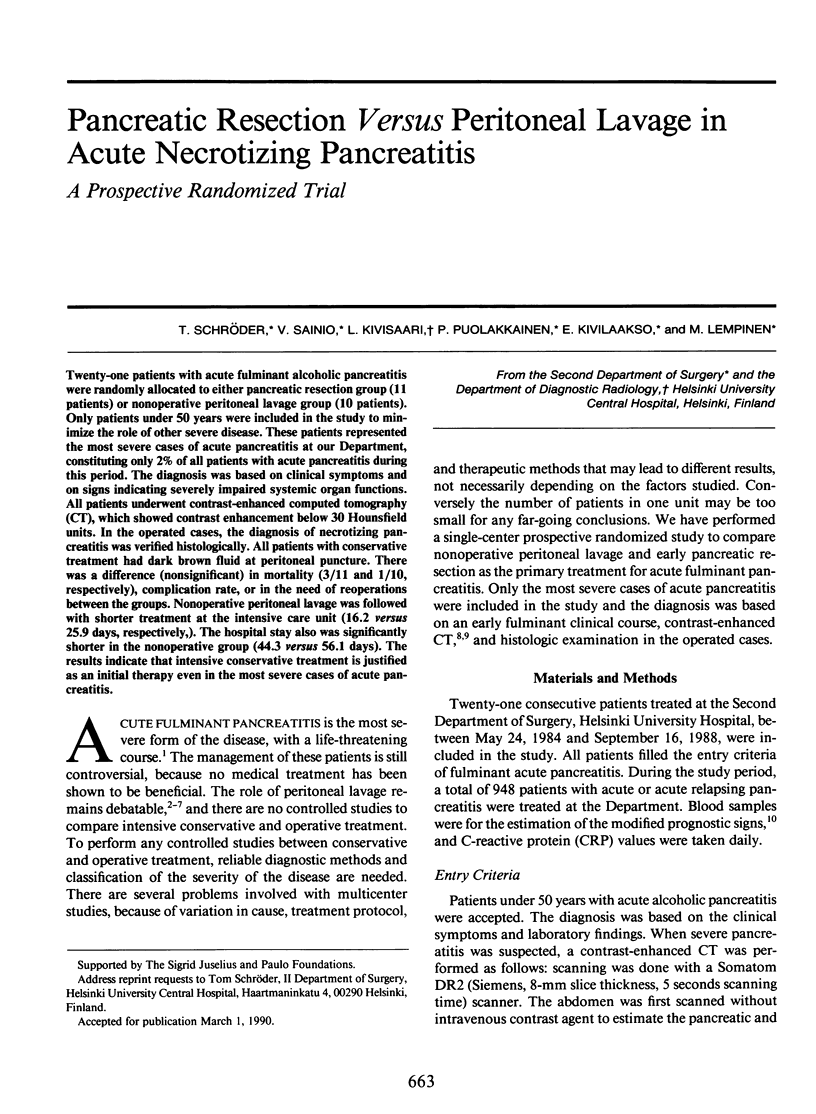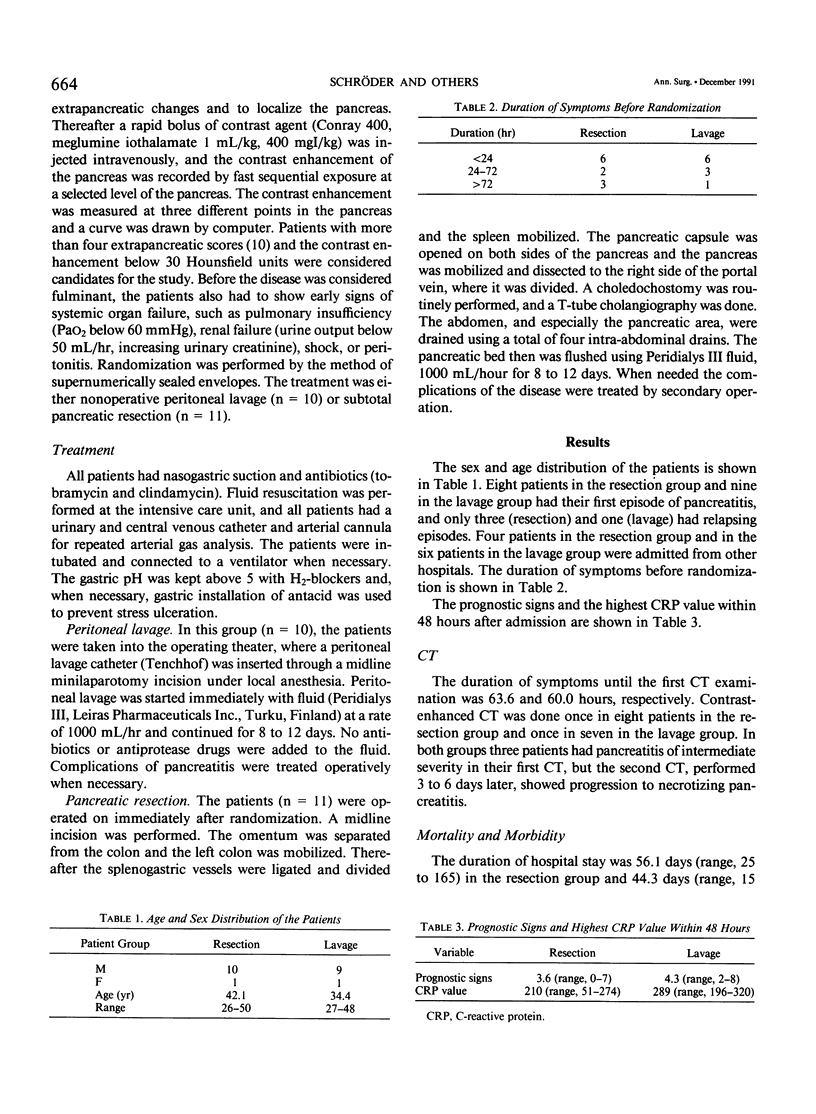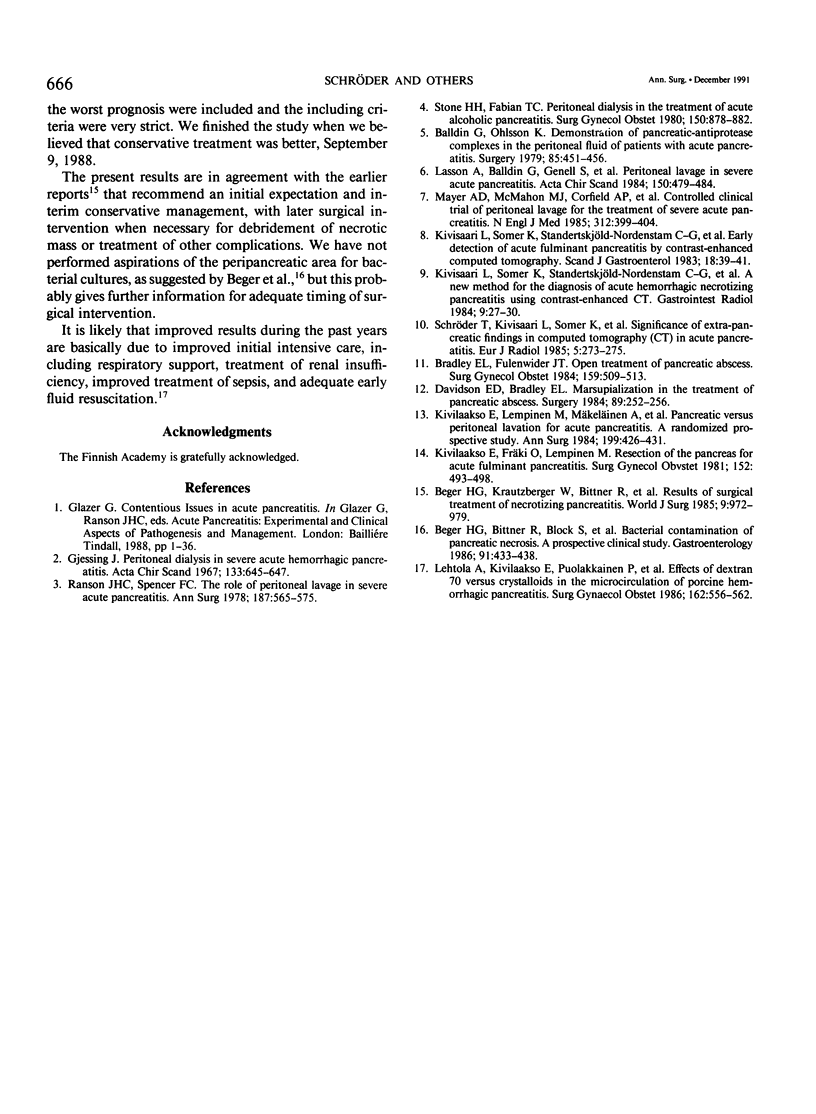Abstract
Twenty-one patients with acute fulminant alcoholic pancreatitis were randomly allocated to either pancreatic resection group (11 patients) or nonoperative peritoneal lavage group (10 patients). Only patients under 50 years were included in the study to minimize the role of other severe disease. These patients represented the most severe cases of acute pancreatitis at our Department, constituting only 2% of all patients with acute pancreatitis during this period. The diagnosis was based on clinical symptoms and on signs indicating severely impaired systemic organ functions. All patients underwent contrast-enhanced computed tomography (CT), which showed contrast enhancement below 30 Hounsfield units. In the operated cases, the diagnosis of necrotizing pancreatitis was verified histologically. All patients with conservative treatment had dark brown fluid at peritoneal puncture. There was a difference (nonsignificant) in mortality (3/11 and 1/10, respectively), complication rate, or in the need of reoperations between the groups. Nonoperative peritoneal lavage was followed with shorter treatment at the intensive care unit (16.2 versus 25.9 days, respectively). The hospital stay also was significantly shorter in the nonoperative group (44.3 versus 56.1 days). The results indicate that intensive conservative treatment is justified as an initial therapy even in the most severe cases of acute pancreatitis.
Full text
PDF



Selected References
These references are in PubMed. This may not be the complete list of references from this article.
- Balldin G., Ohlsson K. Demonstration of pancreatic protease-antiprotease complexes in the peritoneal fluid of patients with acute pancreatitis. Surgery. 1979 Apr;85(4):451–456. [PubMed] [Google Scholar]
- Beger H. G., Bittner R., Block S., Büchler M. Bacterial contamination of pancreatic necrosis. A prospective clinical study. Gastroenterology. 1986 Aug;91(2):433–438. doi: 10.1016/0016-5085(86)90579-2. [DOI] [PubMed] [Google Scholar]
- Beger H. G., Krautzberger W., Bittner R., Block S., Büchler Results of surgical treatment of necrotizing pancreatitis. World J Surg. 1985 Dec;9(6):972–979. doi: 10.1007/BF01655406. [DOI] [PubMed] [Google Scholar]
- Bradley E. L., 3rd, Fulenwider J. T. Open treatment of pancreatic abscess. Surg Gynecol Obstet. 1984 Dec;159(6):509–513. [PubMed] [Google Scholar]
- Davidson E. D., Bradley E. L., 3rd "Marsupialization" in the treatment of pancreatic abscess. Surgery. 1981 Feb;89(2):252–256. [PubMed] [Google Scholar]
- Gjessing J. Peritoneal dialysis in severe acute hemorrhagic pancreatitis. Acta Chir Scand. 1967;133(8):645–647. [PubMed] [Google Scholar]
- Kivilaakso E., Fräki O., Nikki P., Lempinen M. Resection of the pancreas for acute fulminant pancreatitis. Surg Gynecol Obstet. 1981 Apr;152(4):493–498. [PubMed] [Google Scholar]
- Kivilaakso E., Lempinen M., Mäkeläinen A., Nikki P., Schröder T. Pancreatic resection versus peritoneal lavation for acute fulminant pancreatitis. A randomized prospective study. Ann Surg. 1984 Apr;199(4):426–431. doi: 10.1097/00000658-198404000-00009. [DOI] [PMC free article] [PubMed] [Google Scholar]
- Kivisaari L., Somer K., Standertskjöld-Nordenstam C. G., Schröder T., Kivilaakso E., Lempinen M. A new method for the diagnosis of acute hemorrhagic-necrotizing pancreatitis using contrast-enhanced CT. Gastrointest Radiol. 1984;9(1):27–30. doi: 10.1007/BF01887796. [DOI] [PubMed] [Google Scholar]
- Kivisaari L., Somer K., Standertskjöld-Nordenstam C. G., Schröder T., Kivilaakso E., Lempinen M. Early detection of acute fulminant pancreatitis by contrast-enhanced computed tomography. Scand J Gastroenterol. 1983 Jan;18(1):39–41. doi: 10.3109/00365528309181556. [DOI] [PubMed] [Google Scholar]
- Lasson A., Balldin G., Genell S., Ohlsson K. Peritoneal lavage in severe acute pancreatitis. Acta Chir Scand. 1984;150(6):479–484. [PubMed] [Google Scholar]
- Lehtola A., Kivilaakso E., Puolakkainen P., Karonen S. L., Lempinen M., Schröder T. Effects of dextran 70 versus crystalloids in the microcirculation of porcine hemorrhagic pancreatitis. Surg Gynecol Obstet. 1986 Jun;162(6):556–562. [PubMed] [Google Scholar]
- Mayer A. D., McMahon M. J., Corfield A. P., Cooper M. J., Williamson R. C., Dickson A. P., Shearer M. G., Imrie C. W. Controlled clinical trial of peritoneal lavage for the treatment of severe acute pancreatitis. N Engl J Med. 1985 Feb 14;312(7):399–404. doi: 10.1056/NEJM198502143120703. [DOI] [PubMed] [Google Scholar]
- Ranson J. H., Spencer F. C. The role of peritoneal lavage in severe acute pancreatitis. Ann Surg. 1978 May;187(5):565–575. doi: 10.1097/00000658-197805000-00016. [DOI] [PMC free article] [PubMed] [Google Scholar]
- Schröder T., Kivisaari L., Somer K., Standertskjöld-Nordenstam C. G., Kivilaakso E., Lempinen M. Significance of extrapancreatic findings in computed tomography (CT) of acute pancreatitis. Eur J Radiol. 1985 Nov;5(4):273–275. [PubMed] [Google Scholar]
- Stone H. H., Fabian T. C. Peritoneal dialysis in the treatment of acute alcoholic pancreatitis. Surg Gynecol Obstet. 1980 Jun;150(6):878–882. [PubMed] [Google Scholar]


